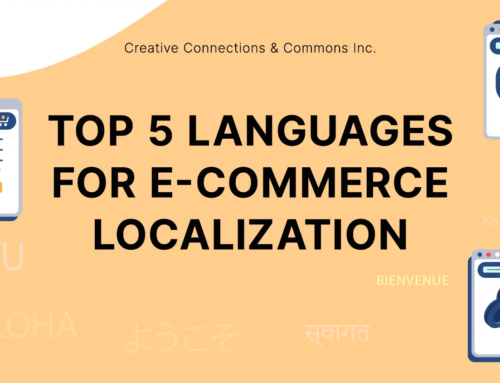Companies that operate internationally often communicate with each other through English. After all, it is a dominant language in the business world. Moreover, the company’s educational content would likewise be in the English language. However, investing in eLearning localization for global team members may offer more benefits than leaving your English content as is.
Companies that rely on bilingual workforces are limiting themselves. Meanwhile, localizing any kind of content is likely to resonate with target audiences more clearly and effectively than foreign content. In this blog, we explore the significance of professional eLearning localization services for global success.
Key takeaways:
- eLearning localization involves making content accessible and understandable for international teams, ultimately boosting engagement and retention.
- Investing in eLearning localization services enhances a company’s success rate in global training programs.
- Only the best eLearning localization providers like CCC can ensure that your global training efforts meet linguistic and cultural demands.
Table of contents:
- Why Localize Your Educational Content?
- What Does the eLearning Localization Process Look Like?
- How Long Does It Take To Localize an eLearning Course?
- CCC: Professional eLearning Localization Service Provider
Why Localize Your Educational Content?
Technology has continuously been improving, giving businesses and educational institutions more opportunities to reach diverse audiences across borders. However, engaging with these boundless prospects is only possible when you resonate with the learners involved.
As such, eLearning content translation and localization are vital in ensuring your international team members are up to speed. Here’s a closer look at why it’s imperative to localize your educational content:
Increase Learner Engagement and Comprehension
According to the United Nations Educational, Scientific and Cultural Organization (UNESCO), learners engage deeply with content in their native language. Thus, localizing educational materials, even in a business setting, may lead to higher levels of engagement.
Engaged learners are motivated. With motivated individuals, learning outcomes would come easier. Giving people access to content in their preferred language are more likely to comprehend and retain information from complex concepts.
Additionally, people would apply knowledge from the lessons effectively. Localized content also reduces the risk of misunderstanding and misinterpretation. In essence, eLearning localization services mitigate language barriers, fostering clear collaboration and communication.
Cater to Diverse Linguistic and Cultural Audiences
Every learner is unique. Some may respond to written instructions better than most, while others might be visual learners. Furthermore, linguistic backgrounds and cultural contexts can come into the mix.
Speaking the language of your learners creates a more immersive and personalized learning experience. By localizing educational content, you acknowledge these differences. In addition, you show that you respect them by offering more inclusive and accessible learning options.
Note: eLearning localization involves more than translation. Put simply, eLearning content translation is a part of the larger localization process. Essentially, localization entails adapting material to suit linguistic needs while recognizing cultural sensitivities. Plus, it considers educational preferences of specific target audiences.
Enhance Brand Reputation and Global Competitiveness
Respecting the different learning styles of people demonstrates your organization’s dedication to inclusion. By committing to localized eLearning materials, you enhance your brand reputation by adopting global practices rooted in diversity and equity.
In addition to facilitating quality learning experiences, localizing educational content positions your brand in global education. With internal content catering to your diverse team, you distinguish yourself from competitors that overlook important cultural adaptation.
Furthermore, the enhanced brand reputation you obtain from providing localized content would attract people from diverse backgrounds. These people having tailored content would also boost retention rates. Accordingly, your global reach and influence would expand.
What Does the eLearning Localization Process Look Like?
At a glance, localizing eLearning materials is a comprehensive process that effectively adapts content to a target learner’s preferences. Service providers might have different approaches but here’s a closer look at the general steps to expect.
Content Analysis
Localization experts perform thorough analyses of existing eLearning content. They assess the scope, complexity, and target audience of the educational material. This initial step is vital as it will be the foundation of the final product.
Analyzing content helps detect potential challenges that professional localizers might encounter. Similarly, it can identify opportunities in the process. During analysis, the experts are likely going to come across cultural references and idiomatic expressions that need adaptation.
Translation and Adaptation
Localizing eLearning materials hinges on multilingual translation. This fundamental aspect involves converting content from one language to another. This process requires the preservation of meaning, tone, and context.
However, localization also requires cultural adaptation. That is, literal translations might be nonsensical to the target audience. Instead, the content must resonate with the target audience and align with linguistic norms.
Pro-tip: Having a native speaker of the target language is an excellent practice in quality localization work. These professionals are likely going to have first-hand experience in the cultural norms of the target audience. Thus, they have insights into the examples or scenarios that may need modification to ensure cultural relevance.
Localization Testing
Upon translating and adapting content, localizers must test the localized content. This way, they can ensure its effectiveness in their target audience. Testing is vital to see whether the translated work is functional in terms of language and culture.
This stage of the process involves rigorous evaluation. Factors include language accuracy interface functionality, multimedia compatibility, and overall user experience. Localizers may also get feedback from test users to identify areas for improvement before finalization.
Deployment and Maintenance
Once the professionals have completely tested the localization of eLearning materials, they can deploy the content to relevant platforms. Every company uses different eLearning platforms and delivery channels for their people.
Even after deployment, maintenance is necessary. Continuous monitoring ensures that the localized content remains relevant to the learners. After all, learning material is not cut-and-dry. Information may change over time, making maintenance valuable in guaranteeing accuracy.
How Long Does It Take To Localize an eLearning Course?
Several factors influence the duration of the localization process. Consider the following:
- Content complexity: Localization timelines depend heavily on the complexity of eLearning courses. Depending on their length, subject matter, and multimedia components, technical terms may take longer to adapt.
- Language pair: Some languages have similar linguistic structures and writing systems. Thus, they may require less time for translation and adaptation than languages with significant linguistic differences.
- Quality of source content: Some source content is better in quality than others. Well-structured and error-free source materials can establish a quick localization timeline.
- Scope of localization: Localization includes translation, cultural adaptation, multimedia localization, and quality assurance. These stages influence the overall timeline. Comprehensive localization projects understandably take longer to complete than simple translation tasks.
- Availability of resources: Skilled linguists, subject matter experts, and technical resources are important players in localization. Their availability can impact the overall timeline. Accordingly, limited availability may extend the project timeline.
Typical Duration for Different Stages of the Localization Process
- Content analysis: Depending on the complexity of the eLearning course, content analysis is possible within a week.
- Translation and adaptation: On average, translation and adaptation may take several weeks to months to ensure linguistic accuracy and cultural relevance.
- Localization testing: Depending on the scope of testing and feedback iteration, this stage may take a few weeks to complete.
- Deployment and maintenance: Ongoing maintenance, including updates and revisions, may continue throughout the course’s lifecycle.
CCC: Professional eLearning Localization Service Provider
Localizing eLearning materials enhance the learners’ experiences by making culturally and linguistically relevant content. Accordingly, learners are more engaged and satisfied with the material that they truly understand. Ultimately, this success boosts retention rates and global reach.
As localization professionals, CCC recognizes the impact of eLearning materials in an audience’s native language. We are eager to be a part of your next campaign for global success through localization. Contact us today.









